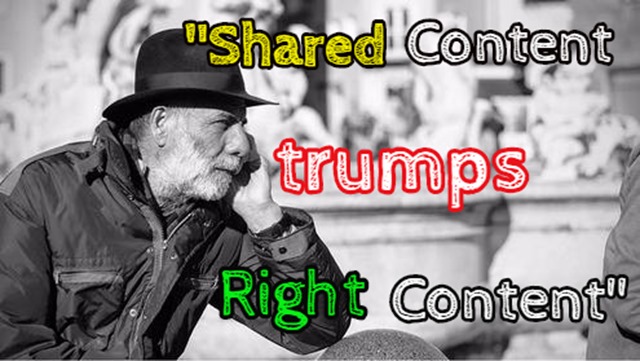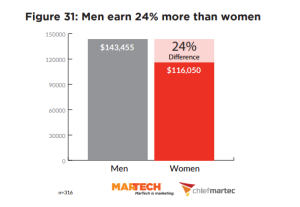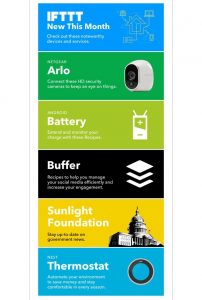
If you’re not promoting your content, it might as well be invisible.
There are more than 2 billion netizens, creating zettabytes of data. An infographic from DOMO shows that on Facebook alone, 2.46 million pieces of content are shared every minute. That’s why, if you want to build authority and increase brand awareness, content promotion isn’t an optional extra, but an essential part of your content marketing strategy in a crowded (maybe even overcrowded) web landscape.
Most marketers already have a few tools in their content promotion bag. As well as social media and mobile marketing, advertising, outreach and PR strategies will definitely be on the list. But those will be wasted if what you promote isn’t what people want. And the best way to find out is to keep your virtual mouth shut and your virtual ears open. In other words, use listening to figure out what people are talking about, find great content, and identify opportunities to share and promote it . These strategies work whether you’re working with your own content or someone else’s.
How Social Listening Works
Most social listening tools work in similar ways. You input words or phrases corresponding to your brand name, niche or key topics and get regular email or mobile alerts about conversations and content related to those topics. Then you have the option to respond to those alerts by sharing or promoting a piece of relevant content.

This strategy really works and you can also get information that can help you with long term business strategy. A case study from Datarank shows how one company leveraged social listening to identify a new product to launch and add $1M to their bottom line.
Tools For Social Listening
There are dozens of tools that help you listen to what’s happening online. These include tools that just do alerts like Google Alerts and Talkwalker Alerts, as well as those that combine social media monitoring with other features. Some tools worth mentioning include:
Tools to consider include:
How To Identify Hot Topics And Shareable Content
There’s another group of tools that’s particularly useful in helping you identify the content that’s most likely to work in your network. These tools show you what your connections and people interested in related topics are already sharing. Not only can you use these tools to share the same content to new audiences, but if you have content related to something that’s already being shared, it’s a good time to promote it.
These days, many social media tools try to be all things to all people, so you can get content sharing recommendations on Klout and Buffer, and Scoop.it‘s home page also helps with this. Swayy is purpose built for this function. These sites combine the data they have on your network and usual topics to suggest other people’s content you might want to promote.

See this comparison of Swayy and Scoop.it to see how you could use them.
Whichever tool you use, spend some time configuring it to match your interests. This saves time later, as you will be able to identify shareable, relevant content with a couple of clicks.
How To Look Into A Crystal Ball With Buzzsumo
One tool I really like is Buzzsumo, which can help you identify the content that’s doing best in your niche in terms of social sharing. You can even use it to find out how your own content is doing, as in this screenshot.

To do this you input a URL or a phrase, use the filtering tools in the left column to set the parameters and wait a couple of seconds for the results to appear.
Not only does Buzzsumo tell you what’s popular now, but the data it provides can help you predict the future. After all, if a topic is consistently popular, it’s a fair bet that sharing additional content on that same topic will help raise visibility for your business.
You can use Buzzsumo to examine the content you plan to share and see whether it will be popular. It’s a bit of a gamble, but it’s based on actual data. For each piece of content, ask yourself:
- Does it match the kind of content that influencers are already sharing? (Buzzsumo also lets you track social media influencers.)
- Is it related to something that will be topical soon? (For example, a major sporting or industry event.)
Jay Baer of Convince and Convert illustrates how the site used Inbound Writer to do this type of predictive content analytics, resulting in double the number of page views and four times the number of organic search visits.
Refining The Audience
By the end of this process you should have a good idea of what content you should share and some of the people who will be interested in reading or amplifying its reach by sharing it with their networks.
It’s also important to use other sources to identify your audience and make your targeting even more exact. The more you tailor content to your audience, the more effective it will be. To do this, check out the demographic and interest information available in tools like Google Analytics, Twitter Analytics, Facebook Page Insights and more. This will help you determine whether you are reaching the people you really want to reach.
Content Promotion And Timing
When you know what you want to share and who you are targeting with content promotion, the next step is figuring out when to share it. Obviously, if you’re promoting content around a big event, you need to promote far enough in advance to allow people to plan and sign up.
But what about everyday content promotion? That’s where you have to think about social timing. There are many studies on this and they don’t all agree. Two studies based on in-depth data come from Kissmetrics and Buffer.
Kissmetrics believes that if you schedule updates to reach those in the Eastern and Central time zones, 80% of your potential audience will see them. Buffer suggests that scheduling updates on Thursdays and Fridays results in higher engagement on Twitter and Facebook. And Social Media Examiner suggests that if you’re promoting content on LinkedIn, you should stick to business days.
Those issues aside, you want to get your content in front of as many people as possible. That means setting a schedule for promoting it.
For my own work, I use a tool called CoSchedule (reviewed on Basic Blog Tips). This lets me schedule social media updates on different platforms at different times relative to the date of content publication. While it automates the posting, you still have to create the updates yourself, with help built into the tool. CoSchedule’s CEO, Garrett Moon, uses it to promote his blog posts over a two month period.
Neil Patel, of Quicksprout, Kissmetrics and CrazyEgg, divides his content promotion strategy into activities for the day and week the content goes live, plus ongoing activities. His strategy integrates social media promotion with email marketing and also involves finding influencers to extend the reach of the content.
How To Tailor Your Message To Meet Your Goals
One important issue is tailoring the message to each site. That could mean choosing a mix of image and text updates (images are proven to result in more sharing) or tweaking the text depending on your goals.
For example, if you want people to come back to your site, you need a call to action in your social media update. If you are looking to start a conversation around a piece of content, then ask an open question to invite discussion. Or you might simply want to share your opinion or make a controversial point that others might want to refute.
Paying For Content Promotion
The strategies and tools outlined above will help you promote content for free, but sometimes that’s not enough. As Matthew Gratt says on Convince and Convert, “nothing markets itself”. Sometimes it’s worth paying to make sure your content gets in front of the right people at the right time so that they will engage with your brand or act on your campaign.
Paid promotion doesn’t have to cost a ton (you set the CPC budget) but can result in a ton of buzz and can increase brand awareness. Paid promotion can help you get content in front of:
- people who are already engaging with similar content
- people who are influential around particular topics
- people who could be interested in your offer
- people who are searching for information on certain issues
- tools for paid promotion include:
- PPC ads
- Social ads on Facebook, promoted tweets on Twitter, sponsored content on LinkedIn and promoted pins on Pinterest (as well as similar options on other sites.
- Content discovery sites like Stumbleupon
- Reddit
- Content promotion networks such as nRelate, Outbrain and Taboola
Here’s a case study from Wil Reynolds showing how paid promotion worked for him.
Conclusion
Social listening can help you find the right content to promote. Audience analysis helps you find the right people to share it with and paid promotion expands your reach. All three work together for a killer content promotion strategy.
Now it’s your turn: what are your favorite content promotion strategies and tools?
* Leader image made with photo by Markus Goller
Sharon Hurley Hall is a professional writer and blogger. Her career has spanned more than 20 years, including stints as a journalist, academic writer, university lecturer and ghost writer. Connect with Sharon on her website
How To Find The Best Content Promotion Opportunities
The post How To Find The Best Content Promotion Opportunities appeared first on Search Engine People Blog.
(402)








